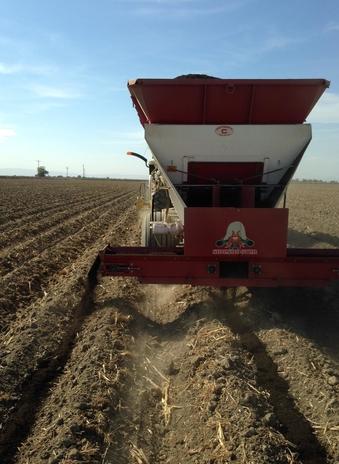Frank Muller - Muller Ranch
Large-scale Diversified Organic and Conventional
The Muller Ranch, grows organic and conventionally managed tomatoes, peppers, cucumbers, sunflower, walnuts, almonds vine grapes, olives, alfalfa, squashes, millet, wheat, corn, safflower, canola, and garlic on several thousand acres in Yolo County, where Joe Muller & Sons, as the family enterprise was formerly known, was founded in 1967.

The Muller brothers with father Joe.
|
Organic Matter Additions
Soil fertility management includes regular applications of organic materials in addition to synthetic fertilizer additions, and soil organic matter is measured every other year in every field. Mostly green waste and sometimes poultry manure composts are applied in the fall at rates of 5-7 tons per acre in every conventionally managed field. The compost addition rates depend on the nutrient analysis results of the composts, the previous crop and the measured organic matter and nutrient status of each field. Currently, the compost is applied in a trench formed in the middle of the bed above the drip tape (see picture). The compost is then covered with soil using a bed-shaping implement. Covering the compost keeps it from being blown away.

Organic Management
About 8% of the acreage at Muller Ranch is organically managed. A cover crop, mostly vetch, is grown every winter in the organic fields, and about 7-8 tons of compost per acre are applied. In the organic fields, the compost is broadcast and disked in because the organic fields are furrow-irrigated to allow the roots to take up nutrients from a greater soil volume than they could under subsurface drip irrigation, which does not wet up as large a volume as furrow irrigation. Most of the conventional production is under subsurface drip irrigation. Soil sampling in the organic fields has shown higher soil organic matter and potassium levels than in the conventionally managed fields. Frank is eager to move more fields into organic production. ‘There are now many more markets for organic produce, not only for tomatoes like a decade ago,’ he says. In addition, the newly created Federal ‘Transitional Certification’ label helps growers obtain intermediate premium market prices and offset some of the increased production costs – higher with organic management – during the three transitional years before a piece of land can be organically certified.
Challenges of Nutrient Management
The greatest challenge to the Muller Ranch management strategy, which relies on close monitoring of nutrient and organic matter levels in individual fields, has been the lack of fertilization guidelines for some specialty crops, such as peppers, cucumbers, or squash. Frank initially used fertilization guidelines from other crops, such as tomatoes, to plan nutrient additions in systems for which little research applicable to California conditions has been published. Although fertilization guidelines for such crops may have been developed in other regions, harvest practices dictated by the market rendered them inaccurate. For example, when Frank grew 2-inch long cucumbers for pickling that were all harvested on the same day, the soil sampling and crop analysis results showed that the crop had been over-fertilized, perhaps because the guidelines had been developed for larger cucumbers or an extended harvesting period stretching over weeks. A similar situation occurred with peppers. Frank thinks the currently available fertilization guidelines for peppers are too high and not meaningful for mechanized harvest systems. Other challenges arise when the expected yields do not materialize due to unfavorable weather or disease outbreaks. For example, they budget N additions in tomato for 60 ton harvests, but in ‘down years’ much N may be left in the soil and nutrient management going forward must be adjusted. Overall, nutrient management in the annual crops present greater challenges to the Mullers’ soil management than perennial crops, for which robust guidelines are available.
Sustainability
A major buyer of the tomatoes produced on the Muller Ranch some years ago asked Frank to document ‘sustainability’ on the family ranch, and Frank felt challenged by this customer and by the consumers. Together with his son he produced a sustainability plan that has become widely cited. It includes topics such as biodiversity, agrochemicals and fuel, waste disposal, and social and human capital. Each year he reports on the successes and setbacks in achieving the goals stated in the plan. In line with California’s goals of reducing greenhouse gas emissions, energy has recently been in the forefront on the path to becoming more sustainable at the Muller Ranch. They took advantage of the recent Pacific Gas & Electric Company incentives and installed enough solar panels on the roof of their barn to generate solar energy to power 12 pumps on the ranch. Some of the newer diesel pumps remain. ‘The next frontier will be an electric fleet,’ Frank muses.
Annual Soil Sampling
The backbone of nutrient management, as Frank Muller explains, is regular soil sampling before side dress fertilization ‘every year in every field.’ Records for every field are kept in spreadsheets and long term trends and year-to-year changes inform the annual fertilization plans for each field. Cost reduction and the strong desire to use environmentally sound farming practices were the motivations for this methodical approach to nutrient management. ‘It makes sense not to waste resources, such as fertilizer, pesticides, water. A few hundred dollars for soil sampling can save you thousands in fertilizer costs when spring sampling shows that nutrient levels are high,’ Frank says. At times, they have been able to grow a crop without any fertilizer addition.
Nitrogen & Potassium
Among the macro nutrients, nitrogen has always been a focal point because of its variable, dynamic nature and the problems it can cause in the environment. Decisions on nitrogen additions are based on soil sampling and crop N off-take, which of course cannot always be reliably predicted. ‘Nitrogen management is an on-going learning process,’ Frank declares. ‘By keeping track of all the information on each field, we have been able to tweak our nitrogen rates down without running great risks.’ Lately, Frank and his brothers also pay a lot of attention to potassium. Soil sampling has shown highly variable potassium concentrations from field to field, with some fields being very high and others below 200 ppm (0.51 meq/100 g), which they consider too low for optimal production of a tomato crop.
Pros and Cons of Conversion to Subsurface Drip Irrigation
Most of the crop land, except the fields in organic production, is either subsurface drip- or microsprinkler-irrigated.
Pros:
- Applied water use on subsurface drip irrigated fields went down 40%, and yields increased by 25%.
- Water use with subsurface drip irrigation (SDI), measured twice by outside organizations at the Muller Ranch, is about 1.7 acre-feet for tomatoes.
- Frank thinks that they made it through the recent drought without serious setbacks due to the SDI. He counters the argument that SDI has led to cropping intensification and greater water use on the landscape scale by pointing out that in this region, most of the farmland has been in production for a very long time.
- Frank sees the greatest tradeoff with implementation of SDI was that wildlife lost access to water. ‘Many slews and ditches with water in them during the summer time have disappeared,’ Frank observes, ‘those were important sources of water for wild life, including pollinators. Nowadays we put water out for pollinators in some places.’
Cons:
- SDI did not save labor costs compared to furrow-irrigation.
- Too many gophers in this area cause a lot of damage to the drip tapes.
